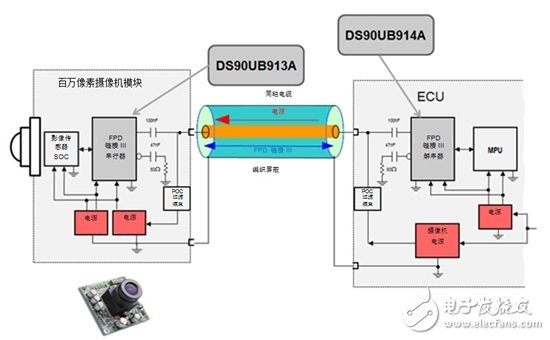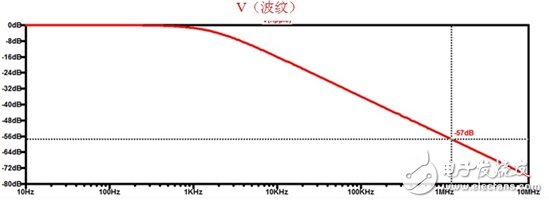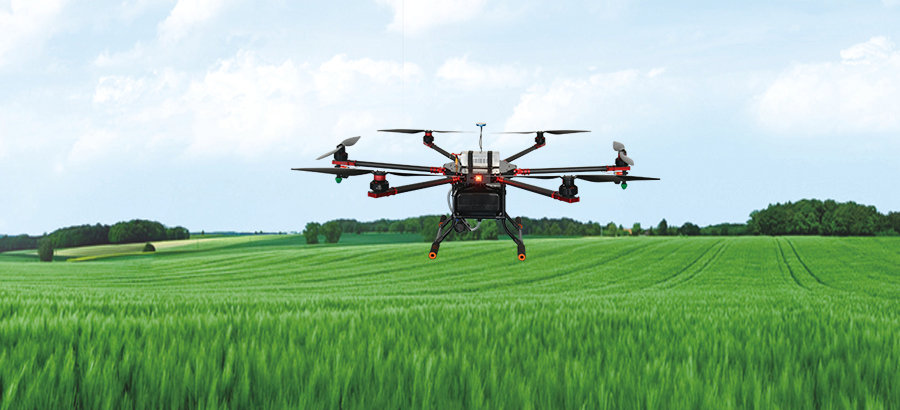As automakers use more cameras and sensors to achieve automotive safety requirements, Coaxial Power (PoC) provides a compact solution for automotive designers looking to reduce body weight. However, there is nothing in the world that can cause problems when delivering power and front and rear channel signals over the same cable. In addition, the car battery used to power the system will produce a wide voltage offset as low as 3V during cold start operation and 42V under clamp load dump or other transient conditions. A well-designed power supply system is essential to ensure that critical systems such as the Advanced Driver Assistance System (ADAS) operate in any car condition.
Figure 1 shows an example of an ADAS system equipped with a popular flat panel display (FPD) link III digital video interface. The deserializer transmits power and control signals over the coaxial cable, and the serializer also sends back video signals over the cable. The system has four significant power modules: the deserializer power supply, the camera power from the deserializer side, the serializer power supply, and the camera image sensor power supply.

Figure 1: Megapixel camera system block diagram
The biggest challenge of a megapixel camera system is the potential voltage drop of the coaxial cable. To ensure that the voltage drop does not introduce signal integrity issues, increase the deserializer voltage to at least 9V before transmitting the PoC. Once power is delivered to the serializer side, the voltage must be returned to the operating voltages used by the serializer and image sensor.
Let's break down these block diagrams. Starting from the serializer side, size is a major consideration (and noise and power supply rejection ratio [PSRR]). I recommend the LM53600-Q1 buck converter and the LP5912- for serializer power and image sensor power supplies. Q1 Low Dropout Regulator (LDO). The LM53600-Q1 features a wide input voltage range of 3.55V - 36V, transient voltages up to 42V, 23μA quiescent current (IQ) and 3mm &TImes; 3mm package size. It is also recommended to use the LP5912-Q1 with a power supply rejection ratio of 73dB at 1 kHz, an output noise of 12μVRMS, a quiescent current of 30μA, and a package size of 2mm &TImes; 2mm. Because power supply ripple and noise directly affect image quality, high power supply rejection ratios and low output noise are critical for camera applications. Since both devices operate with very few external components, miniaturization of the overall solution size is achieved.
On the deserializer side, the power module of the deserializer is similar to the power module of the serializer. In addition, in order to save bill of materials (BOM) costs, it is recommended to use LM53600-Q1 and LP5912-Q1. In this case, you don't have to start with size to save costs, so you can use other solutions. However, these solutions may require more external components and increase overall design costs. To avoid using additional components, you can visit TI.com to see other possible solutions for your design.
Finally, the camera power module is responsible for delivering power from the deserializer to the serializer over the coaxial cable. The power from this module must be boosted to 9V and matched with the signal path. According to Section 8.5 of the DS90UB91x datasheet, the differential output voltage |VOD| (DOUT+ and DOUT-) is only between 269mV and 412mV. This means that the output of the module must be sufficiently free to avoid affecting the signal-to-noise ratio (SNR). Fortunately, the PoC filter used to ensure that the serializer and deserializer match 50? impedance can include inductors that help block high frequency ripple from the boost converter. The higher the switching frequency, the greater the attenuation. For this application, I recommend the TPS61093-Q1 with a 1.2MHz switching frequency for boost regulation. As shown in Fig. 2, after installing an inductor of about 100 μH typical value in the PoC filter device, the output ripple is attenuated by about -57 dB, or equivalent to 0.2% of the original ripple voltage from the boost converter.

Figure 2: PoC inductor ripple attenuation
The megapixel camera is one of the many sensors that are indispensable in the automotive industry. As cars use more and more sensors for safety and comfort, using a well-designed system for coaxial power transmission saves cost and space.
Explore our extensive portfolio of automotive certified parts.
Other resources
Read the application note, "Use the coaxial power supply technology for the DS90UB913A design."
Read “Can LDO improve the photo quality of small cameras?†Learn how LOD affects image quality.
DS90UB91xQ-Q1 Data Sheet
Drone Wire Harness has been widely used in the field of drones, and they are extremely important in both civilian and military fields. The performance and quality of drone products, in addition to the monitoring and improvement of the drone operation program, etc., the safety test of the drone's internal wiring harness itself cannot be ignored. The drone wire harness must be strictly tested and inspected before leaving the factory to ensure the safety of the wiring harness from multiple perspectives such as conduction, withstand voltage, and insulation.
As a new type of scientific and technological product, drone has the advantages of small size, low cost and convenient use compared with manned aircraft, so it is used more and more in our lives. Drone can be seen in various fields from the initial entertaining flight performances to aerial photography, logistics, inspection, disaster rescue and other fields. In addition to the further expansion of the application field of drones, the domestic drone market has also been booming in recent years. Industry experts said that my country's drone companies have accumulated a lot in recent years and have grown rapidly, becoming the industry leader.
Among civilian drones, the consumer drone market is relatively large. In addition to being used for civilian use, drones are also of great significance to the future air combat in the military field. Major military countries in the world are stepping up their research and development work, such as the Wing Loong-II UAV and the Rainbow 5 UAV, which have become my country's drone "business card".
Our Cable Assembly is robust and support signal integrity throughout the operation. Designed to maintain the performance of electrical systems in harsh aerospace environments. They Our wiring harness can be used in various aerospace applications, such as drones.
It is very important that the cable assembly must comply with all industry specifications. Strict certification standards must be adhered to, so you must keep this in mind when choosing the right cable assembly for your product.
In addition to Drone Wire Harness, we also have Vehicle cable assembly and Industrial Cable Assembly.

Drone Wire Harness,Drone Wiring Harness,Drone Power Cable Harness,Drone Battery Wire Harness
Kable-X Technology (Suzhou) Co., Ltd , https://www.kable-x-tech.com